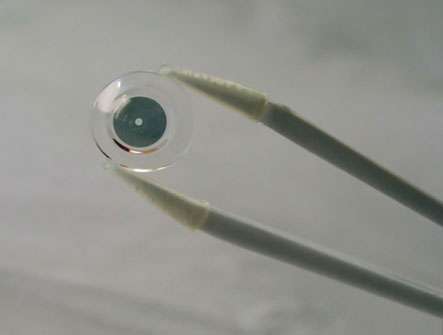April 15, 2012 report
DARPA sets sights on high-tech contact lenses

(Phys.org) -- A Bellevue, Washington, company specializing in display technology based on eyewear and contact lenses has sealed a deal with DARPA. Innovega, which says its technology can open a “new dimension to virtual and augmented reality applications,” told the BBC earlier this week that it has signed a contract to deliver a prototype of its iOptik display system to DARPA. That system consists of special contact lenses and eyeglasses. The product is touted to be a better solution than bulky heads-up display systems of the past. Screens sit directly on users' eyeballs and work with a pair of special lightweight glasses.
Head-up-displays, for DARPA, have been an area for funded research, for better enabling those in the military to view superimposed data over normal views. Innovega’s distinguishing feature, as the company describes it, is in the form factor. The HUD is more like sunglasses than other hefty HUD display sets designed for the military. The iOptic system is made to enhance normal vision by allowing a wearer to view virtual and augmented reality images without the need for bulky apparatus.
From the military vantage point, the glasses plus lenses system would give the battlefield combatants enhanced views of battlefield data. According to DARPA, “Instead of oversized virtual reality helmets, digital images are projected onto tiny full-color displays that are very near the eye. These novel contact lenses allow users to focus simultaneously on objects that are close up and far away. This could improve ability to use tiny portable displays while sill interacting with the surrounding environment.”
The development is part of DARPA’s Soldier Centric Imaging via Computational Cameras (SCENICC). The program seeks to explore joint design of hardware and software that can give “warfighters access to systems that greatly enhance their awareness, security and survivability.”
Users can look at two things at once, both the information projected and the more distant view. The retina receives each image in focus. The engineers used nanoscale techniques to develop the lenses, so that they can work as a focusing device with the glasses. The ability to focus the near-eye image is achieved by embedding optical elements inside the iOptik contact lens, according to Innovega. The micro-components do not interfere with the wearer’s normal vision.
The company says its system affords the human eye to see near-to-eye micro-display information simultaneously with the surrounding environment. Beyond DARPA, the company anticipates its technology can be used by the general public, but it will take a few years for that to happen. The product is undergoing clinical trials as part of the US FDA approval process. Possible applications might be gaming, watching big-screen 3-D movies, and future augmented reality devices superimposing images on reality. According to Innovega, the technology may be available to the public towards the end of 2014.
More information: Innovega Inc.
© 2012 Phys.Org





















